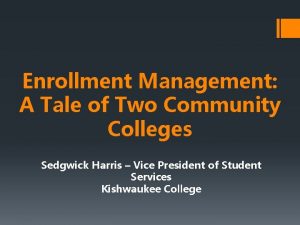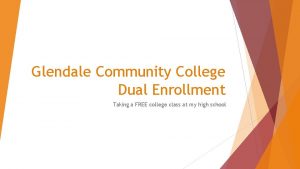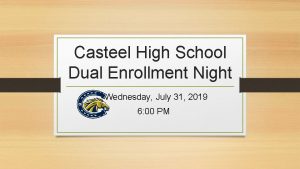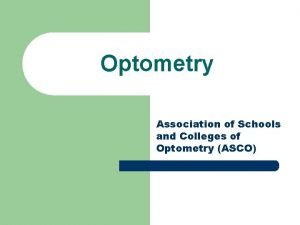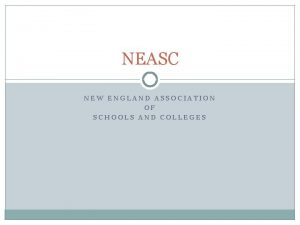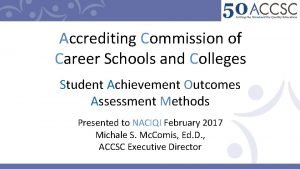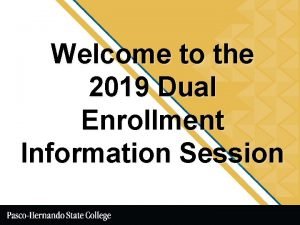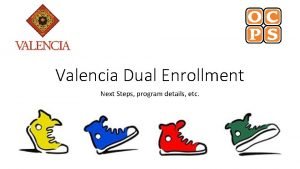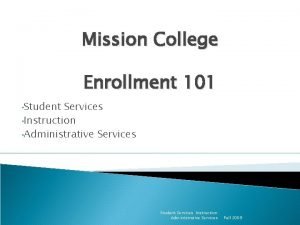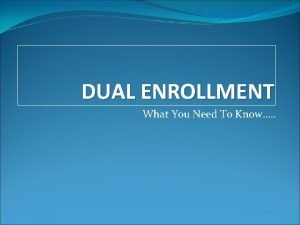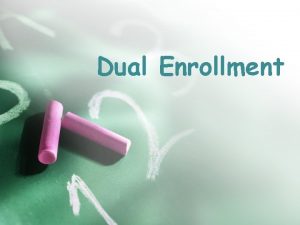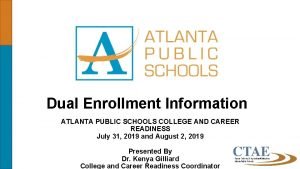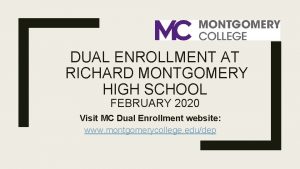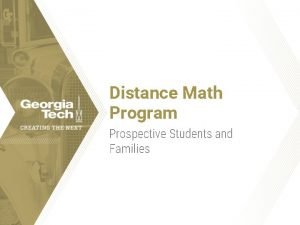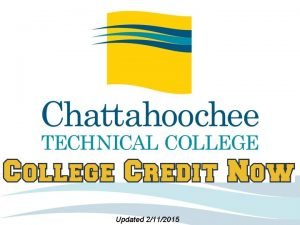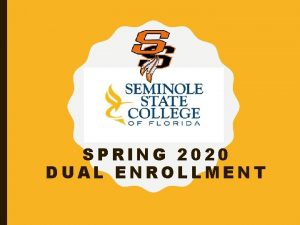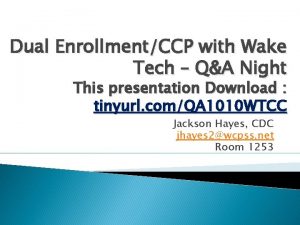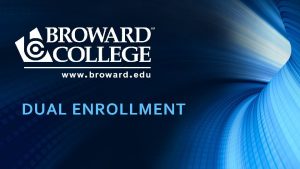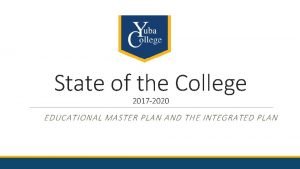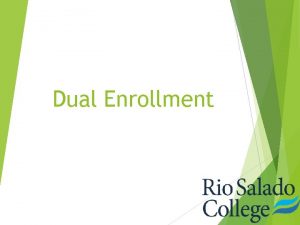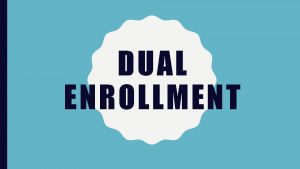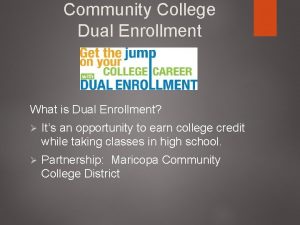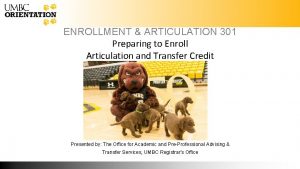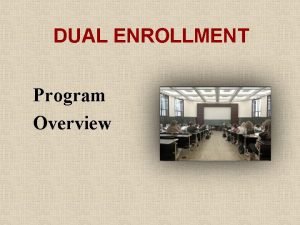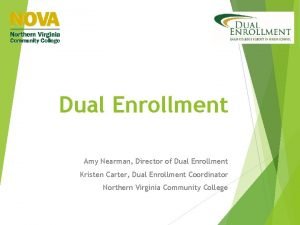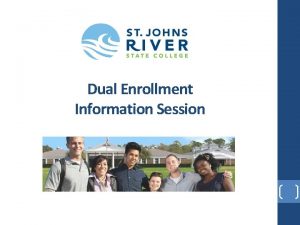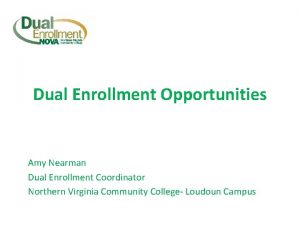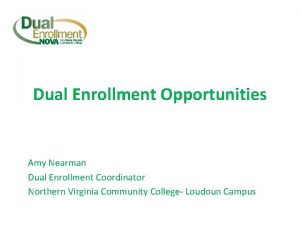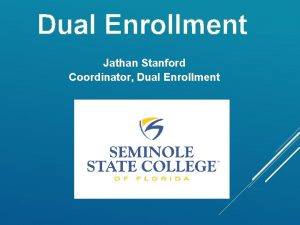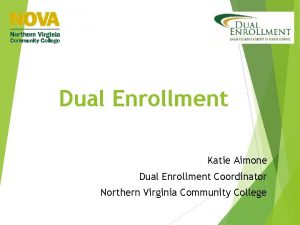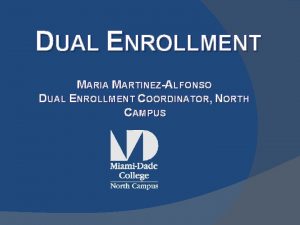Dual Enrollment Articulation High Schools and Community Colleges



























- Slides: 27

Dual Enrollment – Articulation – High Schools and Community Colleges Meeting the Federal Requirements for CTE in California Moderated by: Sherry D. Davis, Ed. D. , Education Programs Consultant Career Technical Education Administration and Management office Career and College Transition Division CALIFORNIA DEPARTMENT OF EDUCATION Tom Torlakson, State Superintendent of Public Instruction

Today’s Objectives: Learn the difference between dual enrollment and articulation agreements Learn about minimum qualifications for California Community Colleges Learn about the processes of working with the California Community Colleges for CTE agreements (dual enrollment v. articulation) 2

Panelist Introductions: Community College Panelists Kris Acosta, Articulation Liaison California Community College Academic Senate Teri Munger, SB 1070 Director/Deputy Sector Navigator, American River College Eva Jimenez, CTE Dean, Shasta College Marnie Melendez, CTE Counselor, Oxnard College Bob Hawkes, Director of Workforce Development, Kern County CCD High School Panelists Marianne Williams, Perkins Coordinator, Anderson Union High School District Jazmin Chavez, Perkins Coordinator, El Rancho USD Dr. Mariane Doyle, CTE Director, William S. Hart USD Joey Adame, Perkins Coordinator, Gridley USD Dan Renninger, Perkins Coordinator, Middletown USD Judie Baumwirt, Perkins Coordinator, Granada Hills Charter HS Sheri Jensen, Perkins Coordinator, Eureka City Schools 3

Student HS Teacher College Faculty CTE/DE Coordinator Articulation Student receives verification (certificate) after completing the articulated HS course. �Not enrolled at the college while taking the course �Student enrolls at CC and meets with CC Counselor, student is placed in the next course in the sequence �No credit nor grade is awarded �No student fees. Student is enrolled for HS credit �Student names are given to CC through automated system (CATEMA) or through hand written documentation. �The teacher distributes the certificates of articulation to each student. �Does not need to meet CCCCO minimum qualifications �HS receives ADA. �Review HS outline to determine similarities in content and rigor to CC Course �Communicate with HS Teacher to ensure that students are prepared for the next course in the sequence. Prepares the Articulation Agreement on an annual or biannual basis and secures signatures. �Prepares certificates of articulation. �Facilitates HS to CC Faculty relationships. Articulation with Credit by Examination Students “opt-in” for college credit �Students apply to the college but are NOT enrolled in a CC course. �Upon successful completion of the End of Course Assessment (EOCA), students receive a letter grade on the transcript with credits awarded. �No student fees. Student is enrolled for HS credit �Student names are given to CC through automated system (CATEMA) or through hand written documentation. �The teacher may proctor the EOCA �Does not need to meet CCCCO minimum qualifications �HS receives ADA. Review HS outline to determine similarities in content and rigor to CC Course �Communicate with HS Teacher to ensure that students are prepared for the EOCA �Administer exam or approve HS exam or determine appropriate EOCA Prepares the Articulation Agreement on an annual or biannual basis and secures signatures. �Prepares EOCA student credit data via CATEMA or paper methods. �Facilitates HS to CC Faculty relationships. Dual Enrollment Student completes a CC application for enrollment at the start of the semester they are to receive credit. �Section Number created at the college. �No student fees (if CA resident). �Student is a HS student and Student is enrolled for HS & CC credit and credit is awarded at the end of the semester. �Teacher is approved as a CC adjunct instructor. Teacher may receive a CC stipend, for attending an annual meeting, teaching course content & submitting college grades. �Teacher is evaluated and receives feedback from CC corresponding department. Review application for HS Teacher to become adjunct faculty �Evaluates HS Teacher �Current college curriculum therefore no additional approval needed to begin �College may collect apportionment if section is listed in Course Catalog and MOU with Facilitates collaboration and follow-up with each instructor, HS & CC. �Assures that course content is being covered (college textbook and adherence to CC course outline). �Annual curriculum meeting by department (instructor, HS administration, CC

Definitions: Duel Enrollment = By definition, dual enrollment offers students an opportunity to complete college-level coursework to earn college credits while they are pursuing their high school diploma (E. Barnett, personal communication, November 19, 2013; J. Kim, personal communication, November 19, 2013; J. Vargas, personal communication, November 20, 2013). Different models exist (see Table 1) with variations in who teaches the courses (college-approved high school teachers or college instructors), where the programs are offered (on a college campus or at the high school), and who can participate (students who meet certain academic benchmarks [e. g. , test scores, number of credits completed, GPA] or anyone who has the desire to enroll in the program; Karp, Hughes, & Cormier, 2012). Some efforts have a career and technical education focus versus solely an academic one, while other programs offer high school and college credit for college courses (Hughes, Rodríguez, 5

Definitions: Articulation = An articulated high school course is a high school course or courses that the faculty in the discipline have determined to be comparable to a specific community college course. Students whom have taken an articulated high school course may be able to earn college credit by choosing to participate in a credit by examination process. Specific credit by examination processes vary by institution. (Statewide Career Pathways, 2015) 6

Definitions: Concurrent Enrollment = The term concurrent enrollment is also used to describe dual enrollment programs and in some cases, refers to high school students who are enrolled in college courses that are taught by high school teachers at the high school and/or community college students. It could also refer, although not for purposes of this report, to community college students who take courses at University of California campuses or California State Universities (Golann & Hughes, 2008). 7

Define what CTE articulated courses from a high school to a community college should look like…. 8

What is the difference between the old “ 2+2” model and Articulation Agreement, Dual Enrollment, or Concurrent Enrollment? 9

Can you give more examples of the differences between: Articulation Agreements Dual Enrollment Concurrent Enrollment 10

What is the current AB 1451 status? How will it effect high schools and community colleges ? 11

Why have the articulation or dual enrollment agreements, if the student still has to do a credit by examination? What is the benefit to the student? 12

What value does articulation agreements of high school courses have for students… If it does not produce actual college credit on their transcripts? 13

Why shouldn’t credit be granted towards the associate degree, itself for articulated high school courses? 14

What does it take for a credentialed HS CTE teacher to be recognized as meeting the “Minimum Qualification” (so you can have dual enrollment courses) 15

Minimum Qualifications for California Community Colleges For most of you, minimum qualifications (MQ) will be a simple matter. For instance, if you wish to teach U. S. History and you possess a master’s degree in U. S. History, there is no doubt that you qualify to pass the first hurdle of employment—meeting the educational MQ for the position. As you surf through the job announcements in the Registry, you should find the educational requirements in that section of each college’s position description. Generally, there are two groups of educational MQs: those for academic positions and those for vocational positions. Since the bulk of positions are in the academic areas, we will discuss those first. The MQs cited in the position announcement generally follow the following pattern: 1) Possession of a Master’s Degree (or Ph. D) in the discipline, with those acceptable discipline titles determined by the Statewide Academic Senate; or 2) Possession of a Bachelor’s Degree in the discipline and a Master’s in a related field, again determined by the Senate; or 3) Possession of a valid California Community College Teaching Credential appropriate to the discipline; or 16

Most of you fit the MQs in items 1 or 2. My description of this fit is a “slam dunk. ” You should jump over the first hurdle with no problem. Technically and academically, you fill the basic qualifications of the position. (You may skip the next few paragraphs; but, take a look at the “hidden” MQ after those paragraphs. ) Roughly 5% of you can qualify under item 3. Sorry, the issuance of California Community College Credentials was terminated on July 1, 1990. Those that have not expired are still valid; but, no new credentials can be issued, meaning you must qualify under items 1, 2 or 4. (If you hold a valid credential and have lost it, a replacement can be acquired through the Chancellor’s Office, California Community Colleges. The latest telephone number for the appropriate office is (916) 327 -6227 or 445 -1606. ) “What about me? ” you say, “I don’t qualify under 1, 2 or 3? ” There is still hope!

What to do? Don’t give up, call the Human Resources Office of the college and ask “What is the equivalency policy of the district? ” If the response is “huh? ” ask to speak to the Dean, Director, Vice President—whoever should know the answer (you will be short-stopped to the Secretary, who will know!). Most districts have a procedure for this. Don’t over-react and send a lot of material that is extraneous to your case (recommendations from third-grade teachers really don’t count for much).

VOCATIONAL DISCIPLINES With a few exceptions, this is very straightforward. Vocational disciplines do not require a Master’s Degree. A Bachelor’s Degree or Associate Degree will suffice. In addition, the listing from the Chancellor’s Office is not exhaustive, so there is latitude in what fits what. What must be the major for the degree presented? With a few exceptions, any major will do. An example of an exception would be “Nursing Science/Clinical Practice” which would tend to preclude non-Nursing B. A. s because of licensing and liability issues. In programs in which the student receives a recognized certificate, the agency authorizing the certificate may have some control over the requirements for faculty in the program. The easy way of determining if the position is academic or vocational is to look at the degree requirement. However, to state the obvious, the degree is a minimal hurdle; the real criterion for vocational positions is experience in the vocation. With a B. A. you must have two years in the vocation, with an A. A. you must have six years. The “hidden” MQ applies.

Will the community colleges offer credit (grades) for students on their transcripts for: Articulated Courses? Dual Enrollment Courses? Concurrent Enrollment Courses?

Is there a discussion about making these agreements to be curriculum based and not “faculty to faculty” personality based?

Is there a plan/schedule for CTE high school teachers/administrators and regional community college CTE faculty/administrators to do any professional development to work together more on articulation or dual enrollment agreements?

What issues or problems have you had on the high school side to get agreements approved/completed with community colleges currently or in the past?

What issues or problems have you had on the community college side to get agreements approved/completed with high schools currently or in the past?

What do you all need from the state level – Department of Education (CDE) or the Chancellor’s Office (Community Colleges) to help with the process for both levels in California?

What Questions are there for the panelist…. . Articulation Agreement

Thank you to all of you Thanks to all of the panelists here today to help with the ever challenging task of Articulation – Dual Enrollment Concurrent Enrollment
 Community colleges
Community colleges Glendale community college dual enrollment
Glendale community college dual enrollment Basha high school dress code
Basha high school dress code Casteel dual enrollment
Casteel dual enrollment Association of schools and colleges of optometry
Association of schools and colleges of optometry New england association of colleges and schools
New england association of colleges and schools Accrediting commission of career schools and colleges
Accrediting commission of career schools and colleges Washington state board of technical and community colleges
Washington state board of technical and community colleges Community colleges in south africa
Community colleges in south africa Phsc canvas wise
Phsc canvas wise Nvcc dual enrollment
Nvcc dual enrollment Ggc dual enrollment requirements
Ggc dual enrollment requirements Valencia dual enrollment deadline
Valencia dual enrollment deadline Ung dual enrollment classes
Ung dual enrollment classes Mission college dual enrollment
Mission college dual enrollment Zelda glazer middle school
Zelda glazer middle school Dual enrollment pellissippi
Dual enrollment pellissippi Pert test pbsc
Pert test pbsc Atlanta public schools transcript request
Atlanta public schools transcript request Dual enrollment mc
Dual enrollment mc Gatech distance math
Gatech distance math Chattahoochee tech dual enrollment
Chattahoochee tech dual enrollment Ssc dual enrollment
Ssc dual enrollment Ggc dual enrollment
Ggc dual enrollment Ccp wake tech
Ccp wake tech Dual enrollment bc
Dual enrollment bc Emcc dual enrollment
Emcc dual enrollment Www.riosalado/dual
Www.riosalado/dual
